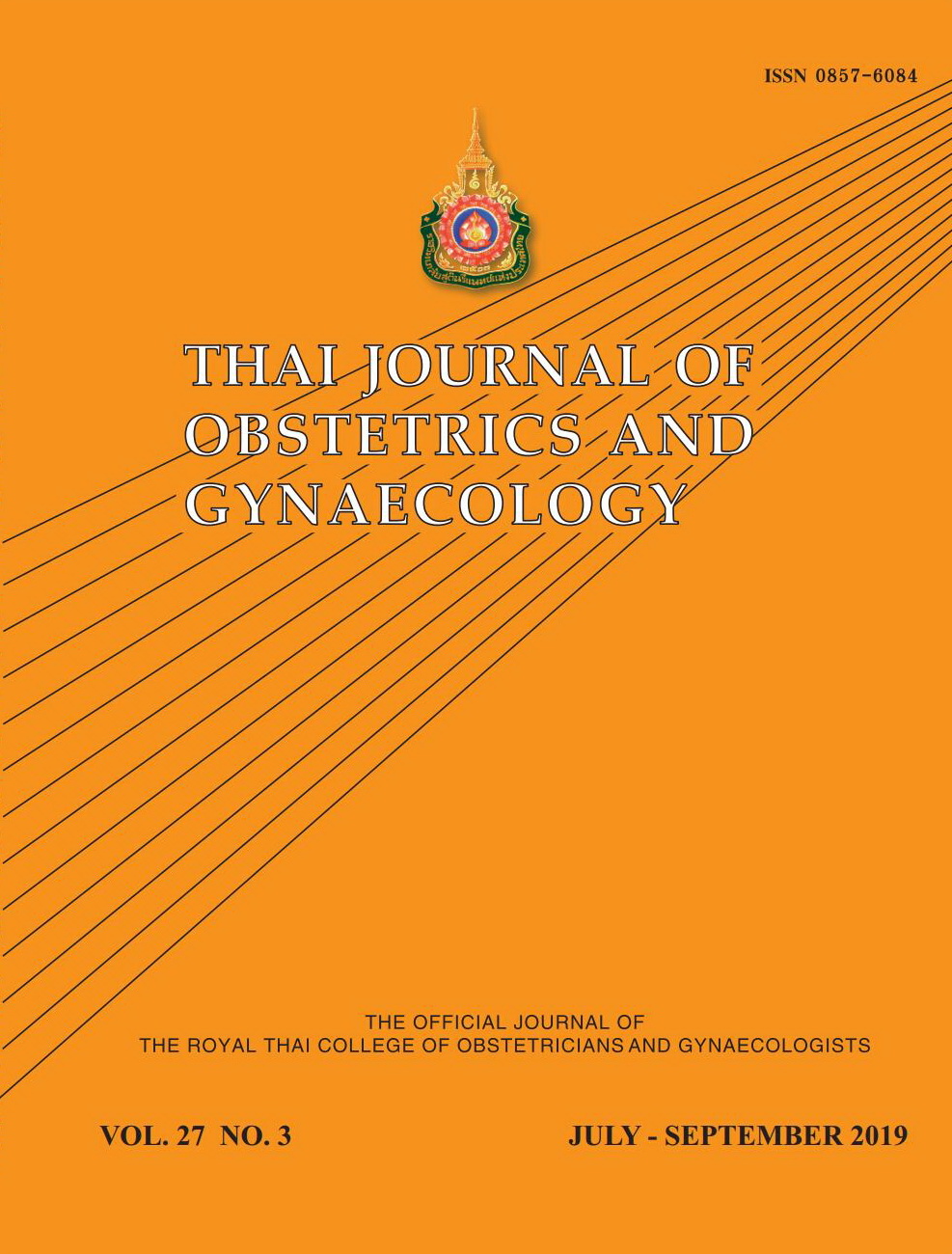The Reliability of Transabdominal Cervical Length Measurement Compared with Transvaginal Measurement at 16-24 Weeks of Gestation
Main Article Content
Abstract
Objectives: To determine reliability of transabdominal cervical length (TACL) compared with transvaginal cervical length (TVCL) at 16-24 weeks of gestation.
Materials and Methods: A prospective study was conducted in the Obstetrics and Gynecology Department at Phramongkutklao Hospital between 27 March 2017 and 29 December 2017. Singleton pregnant women who underwent ultrasound between 16-24 weeks of gestation with any indication were enrolled. Women with a history of cervical surgery, uterine contractions and vaginal bleeding were excluded. After voiding, TACL was measured followed by TVCL as per the protocols stipulated by the Fetal Medicine Foundation (2014). Demographic and medical data were collected. Cervical length measurements from both methods were compared, and the factors accounting for differences in measured lengths were considered.
Results: One hundred and forty-two women with singleton pregnancies agreed to participate in the study. Satisfactory TACL images could not be obtained within 5 min in 12 (8.6%) of the 142 women, and were excluded from the analysis. Of a total of 130 singleton pregnant women, mean TACL and TVCL values were found to be 39.3 ± 6.4 mm and 41.5 ± 7.4 mm, respectively. The mean TACL was found to be shorter than the mean TVCL by an average of 2.2 mm (p < 0.001). An intraclass correlation coefficient between both procedures was found to be 0.443 which was statistically significant (p < 0.001). Similarly, the difference between TVCL and TACL measurements decreased as BMI increased with statistical significance (p = 0.043). The 5th percentile of TACL and TVCL was 31 mm and 32 mm, respectively. None of the patients had a TACL and TVCL < 25 mm which is defined as a short cervix.
Conclusion: The TACL assessment was possible to carry out 91.4% of pregnant women and was moderately correlated with TVCL, therefore, it may be considered as an initial screening tool for cervical length assessment in pregnant women at low-risk for preterm delivery.
Article Details
References
2. Meis PJ, Ernest JM, Moore ML. Causes of low birth weight births in public and private patients. Am J Obstet Gynecol 1987;156:1165-8.
3. Goldenberg RL, Culhane JF, Iams JD, Romero R. Epidemiology and causes of preterm birth. Lancet 2008;371:75-84.
4. Iams JD. Prediction and early detection of preterm labor. Obstet Gynecol 2003;101:402-12.
5. Iams JD, Goldenberg RL, Meis PJ, Mercer BM, Moawad A, Das A, et al. The length of the cervix and the risk of spontaneous premature delivery. National Institute of Child Health and Human Development Maternal Fetal Medicine Unit Network. N Eng J Med 1996;334:567-73.
6. Andersen HF. Transvaginal and transabdominal ultrasonography of the uterine cervix during pregnancy. J Clin Ultrasound 1991;19:77-83.
7. Okitsu O, Mimura T, Nakayama T, Aono T. Early prediction of preterm delivery by transvaginal ultrasonography. Ultrasound Obstet Gynecol 1992;2: 402-9.
8. Hasegawa I, Tanaka K, Takahashi K, Tanaka T, Aoki K, Torii Y, et al. Transvaginal ultrasonographic cervical assessment for the prediction of preterm delivery. J Matern Fetal Med 1996;5:305-9.
9. ACOG.org [Internet]. Washington: Prediction and Prevention Preterm birth. 2012 [cited 2016 November 05]. Available from: https://www.acog.org/Resources%20And%20Publications/Practice%20Bulletins/Committee%20on%20Practice%20Bulletins%20Obstetrics/Prediction%20and%20Prevention%20of%20Preterm%20Birth.aspx
10. Fetalmedicine.org [Internet]. London: Cervical assessment; 2016 [cited 2016 November 05]. Available from: https://fetalmedicine.org/training-n-certification/certificates-of-competence/cervical-assessment-1
11. Fonseca EB, Celik E, Parra M, Singh M, Nicolaides KH. Progesterone and the risk of preterm birth among women with a short cervix. N Eng J Med 2007;357: 462-9.
12. To MS, Alfirevic Z, Heath VC, Cicero S, Cacho AM, Williamson PR, et al. Cervical cerclage for prevention of preterm delivery in women with short cervix: randomised controlled trial. Lancet 2004;363:1849-53.
13. Friedman AM, Srinivas SK, Parry S, Elovitz MA, Wang E, Schwartz N. Can transabdominal ultrasound be used as a screening test for short cervical length? Am J Obstet Gynecol 2013;208:190.e1-7.
14. Marren AJ, Mogra R, Pedersen LH, Walter M, Ogle RF, Hyett JA. Ultrasound assessment of cervical length at 18–21 weeks’ gestation in an Australian obstetric population: Comparison of transabdominal and transvaginal approaches. Aust N Z J Obstet Gynaecol 2014;54:250–5.
15. Peng CR, Chen CP, Wang KG, Wang LK, Chen CY, Chen YY. The reliability of transabdominal cervical length measurement in a low-risk obstetric population: Comparison with transvaginal measurement. Taiwan J Obstet Gynecol 2015;54:167-71.
16. Rozenberg P, Gillet A, Ville Y. Transvaginal sonographic examination of the cervix in asymptomatic pregnant women: review of the literature. Ultrasound Obstet Gynecol 2002;19:302-11.
17. Berghella V. Universal cervical length screening for prediction and prevention of preterm birth. Obstet Gynecol Surv 2012;67:653-8.
18. Romero R, Nicolaides K, Conde-Agudelo A, Tabor A, O’Brien JM, Cetingoz E, et al. Vaginal progesterone in women with an asymptomatic sonographic short cervix in the midtrimester decreases preterm delivery and neonatal morbidity: a systematic review and meta-analysis of individual patient data. Am J Obstet Gynecol 2012;206:124.e1-19.
19. Hernandez-Andrade E, Romero R, Ahn H, Hussein Y, Yeo L, Korzeniewski SJ, et al. Transabdominal evaluation of uterine cervical length during pregnancy fails to identify a substantial number of women with a short cervix. J Matern Fetal Neonatal Med 2012;25: 1682-9.
20. Saul LL, Kurtzman JT, Hagemann C, Ghamsary M, Wing DA. Is transabdominal sonography of the cervix after voiding a reliable method of cervical length assessment? J Ultrasound Med 2008;27:1305-11.
21. Stone PR, Chan EH, McCowan LM, Taylor RS, Mitchell JM, Consortium S. Transabdominal scanning of the cervix at the 20-week morphology scan: comparison with transvaginal cervical measurements in a healthy nulliparous population. Aust N Z J Obstet Gynaecol 2010;50:523-7.
22. Puttanavijarn L, Phupong V. Comparison of transabdominal and transvaginal ultrasonography for the assessment of cervical length at 16–23 weeks of gestation. J Obstet Gynaecol 2017;37:292-5.
23. Kongwattanakul K, Saksiriwuttho P, Komwilaisak R, Lumbiganon P. Short cervix detection in pregnant women by transabdominal sonography with post-void technique. J Med Ultrasound 2016;43:519-22.

